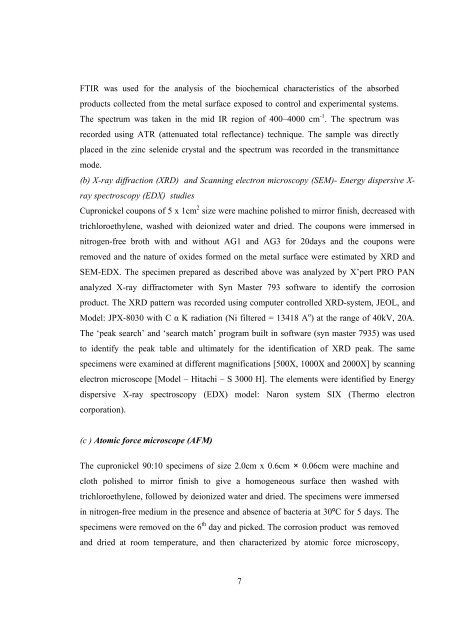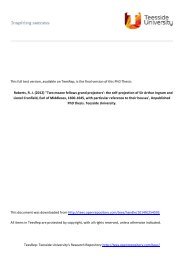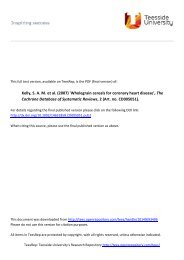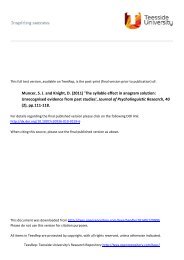Maruthamuthu, S. et al. - Teesside's Research Repository
Maruthamuthu, S. et al. - Teesside's Research Repository
Maruthamuthu, S. et al. - Teesside's Research Repository
Create successful ePaper yourself
Turn your PDF publications into a flip-book with our unique Google optimized e-Paper software.
FTIR was used for the an<strong>al</strong>ysis of the biochemic<strong>al</strong> characteristics of the absorbed<br />
products collected from the m<strong>et</strong><strong>al</strong> surface exposed to control and experiment<strong>al</strong> systems.<br />
The spectrum was taken in the mid IR region of 400–4000 cm -1 . The spectrum was<br />
recorded using ATR (attenuated tot<strong>al</strong> reflectance) technique. The sample was directly<br />
placed in the zinc selenide cryst<strong>al</strong> and the spectrum was recorded in the transmittance<br />
mode.<br />
(b) X-ray diffraction (XRD) and Scanning electron microscopy (SEM)- Energy dispersive Xray<br />
spectroscopy (EDX) studies<br />
Cupronickel coupons of 5 x 1cm 2 size were machine polished to mirror finish, decreased with<br />
trichloro<strong>et</strong>hylene, washed with deionized water and dried. The coupons were immersed in<br />
nitrogen-free broth with and without AG1 and AG3 for 20days and the coupons were<br />
removed and the nature of oxides formed on the m<strong>et</strong><strong>al</strong> surface were estimated by XRD and<br />
SEM-EDX. The specimen prepared as described above was an<strong>al</strong>yzed by X’pert PRO PAN<br />
an<strong>al</strong>yzed X-ray diffractom<strong>et</strong>er with Syn Master 793 software to identify the corrosion<br />
product. The XRD pattern was recorded using computer controlled XRD-system, JEOL, and<br />
Model: JPX-8030 with C α K radiation (Ni filtered = 13418 A o ) at the range of 40kV, 20A.<br />
The ‘peak search’ and ‘search match’ program built in software (syn master 7935) was used<br />
to identify the peak table and ultimately for the identification of XRD peak. The same<br />
specimens were examined at different magnifications [500X, 1000X and 2000X] by scanning<br />
electron microscope [Model – Hitachi – S 3000 H]. The elements were identified by Energy<br />
dispersive X-ray spectroscopy (EDX) model: Naron system SIX (Thermo electron<br />
corporation).<br />
(c ) Atomic force microscope (AFM)<br />
The cupronickel 90:10 specimens of size 2.0cm x 0.6cm × 0.06cm were machine and<br />
cloth polished to mirror finish to give a homogeneous surface then washed with<br />
trichloro<strong>et</strong>hylene, followed by deionized water and dried. The specimens were immersed<br />
in nitrogen-free medium in the presence and absence of bacteria at 30ºC for 5 days. The<br />
specimens were removed on the 6 th day and picked. The corrosion product was removed<br />
and dried at room temperature, and then characterized by atomic force microscopy,<br />
7





